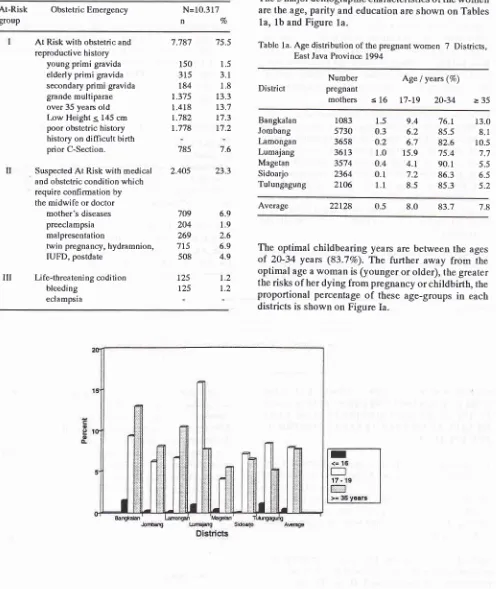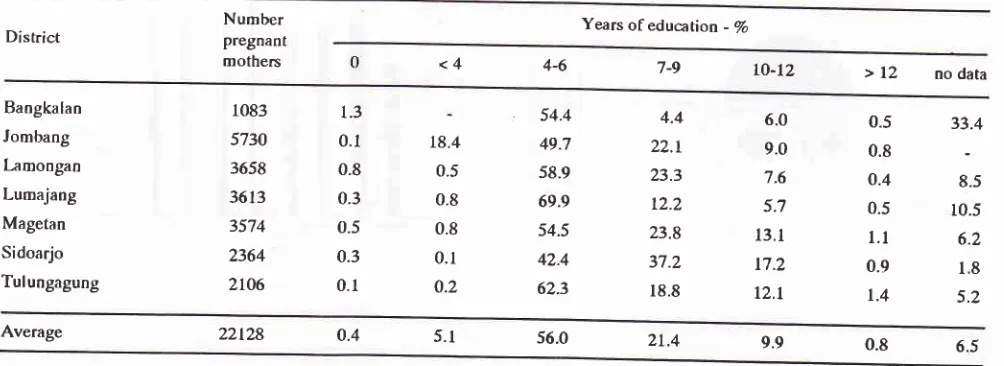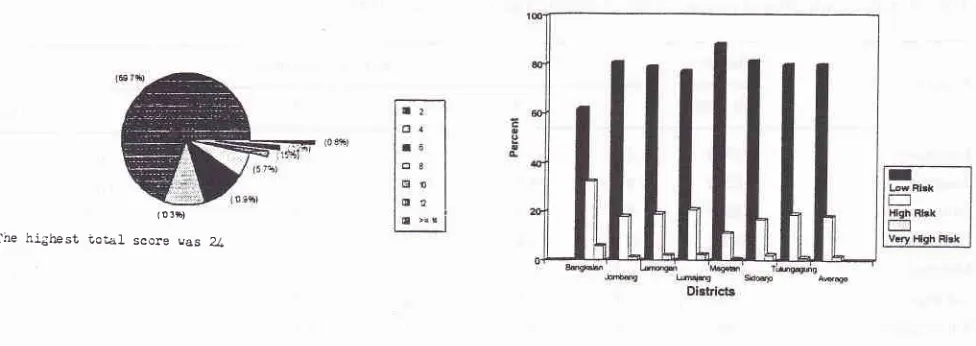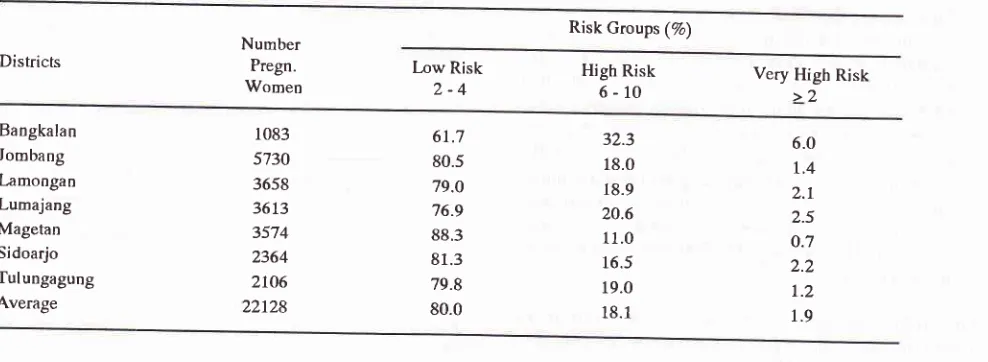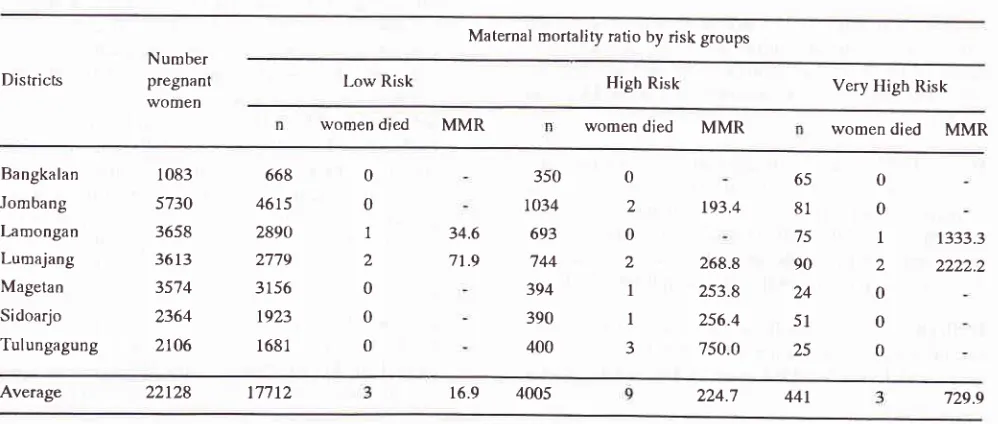Abstrak
Gawat Obstetrik d.ibagi dalam 3 kelompok (l)
poten
a riwayatr
(2) Ada potensi Risiko dengan kondisi medik dan obstetrik, e)Gàwat-Darurat
n skrining poli Hamil RS1D Dr.Abstract
AI ou 16
Keywords : obstetric emergency, antenatal risk screening; maternal health facilities VoI 5, No 2, April - June 1996
Common
Obstetric
Emergency
(Field
Experiences on
community
Based
Antenatar
East Java, fndonesia)
Poedji Rochjati
It
was noted that Indonesia had the highest maternal mortality among the Asean countries. The estimated maternal death rate being42l per 100.000 Live Births,with
an interprovincial variationfrom
130to
750 maternal deaths per 100.000 LB (National Household Survey, 1992).It is estimated that 2}.5}Owomen die each yearon
accountof
pregnancy. Haemorrhage,cs and Gynecologlt, Dr. Soetomo ic ine A i rlang ga U n ivers ity,
at
XVth Asian and Oceanic Congress of and Gynecologt, October 15-20, 19g5, Bali,Common Obstetric Emergency 65
Risk
Screening
in
Village Level in
sepsis and toxaemia, in that order, constitute the major direct causes
of
maternal deaths. Most deaths occur during labor, delivery and in theim
par_ tum period. Actually, a largeproporti
ater_nal
deaths were preventablewit
able associated factors.av
theov
the66
Rochjaticrease number of the maternity facilities has increased access
to ANC
to 8O%.
However, according to the Indonesia Demographic and Health Survey, only 567o have 4 or lnore visits recommended by the Ministry of Health. Delivery care, most wornen continueto
be attendedby
the traditionalbirth attendants
(TBA). Nearly 78%of
women first seek delivery assistancefrom TBAs
and relatives. Midwives are the first delivery assislance sought for l87o of rural deliveries. Orerall 797o of births take place at home.Several factors influence this low utilization
of
the maternity health facilities, like ignorancy, low motiva-tion to travel long distances forantenatal care, poverty, and lack of transport for timely obstetric emergency referral. Many women were unable to reach the district hospitalfor
obstetric emergency within2
hours of travel from their homes. These pregrant mothers werereferred and came
in
the hospitalin
a very seriouscondition. The new expensive and sophisticated tech-nology
in
the hospital seernedstill
unnecessary in solving these problems in the rural areas.PREVENTIVB AND PROMOTIVE APPROACH
ON MATERNITY
HBALTH
CAREIn the new Law
on
Health no.23, 1992 Government oflndonesia has stated a change in orieutation from the curative efforts to a preventive and promotive effortsin
health care. Specificallyfor
the maternity health care, efforts should be pro-actively implemented, deal-ing with healthy women and fetus, with sthrengtening the IEC.Preventive measu.res to reduce maternal mortality In order to provide the necessary preventive measures, routine services and referral care to reduce maternal
mortality in the village level, a three-pronged approach
was implemented
:
1) a stronger community based maternity health care, mainly by Bidan di Desa andother nonformal health workers
like
TBAs, PKK cadres, to screen pregnant women, identify those at risk, followed by IEC to women/husband/immediate family for their awareness of the danger signs and refer as appropriate, 2) a stronger refenal back-up network of health centers with beds and hospitals to take care the increasing awareness and compliancefor early
planned referral of the high risk mothers and prompt timely referral of the obstetric emergency, 3) an alarm and transport system to transfer women with high risk pregnancy and emergencies from the community toreferral facilities in time.
Med J Indones
THE DEVELOPMENT OF THE COMMUNITY BASED ANTENATAL RISK SCREENING FOR THE OBSTETRIC EMERGENCY
ln
1975 this Risk Approach Strategyfor
pregnant women with the slogan : Something for all, but morefor those in need-in proportion to that need' (WHO,
1978) was implemented and a High Risk Clinic was set up for the first time in Dr. Soetomo Hospital, Surabaya the capital city of East Java Province. The criteria for the obstetric emergency and pregnant women with high risk condition was developed. Antenatal risk screening was conducted followed
by
an intensive antenatal care for the high risk women, plan for safe delivery was discussed and recordedin
the medical record as an information for the provider attended her delivery.In
1981 this antenatal risk screening was applied by the midwife in the community, outside the hospital, in Sidoarjo district.Then operational studies on Risk Approach Strategy for pregnant women in primary health care level had been conducted
in 2
districtsin East Java, Sidoarjo
(1989), and Lamongan (1991). Study in Sidoarjo was conducted to investigate the possibility of an interven-tion by a community based antenatal risk screeningwith
the involvement and participationof
PKK
as women health volunteers promote screening, detection of risk factors, give IEC to the pregnant women, move them to seek care for ANC, and urge them for early planned referralif
needed.PKK
move proactively through door-to-door home visits to pregnant women. Studyin
Iamongan showed that the TBA could be involved in these efforts, and build a good integrated leamwork between PKK, TBA Bidan di Desa, Health Center doctor and tnidwife.In Probolinggo district (1993) a study on the use of an antenatal risk screening and referral by the frontline health workers
in
the communityto
reduce poor reproductive outcorne, was a collaborative effort be-tween Dr. Soetomo Hospital, School of Medicine Air-langgaUniversity
with
the Provincial,
District, Subdistrict health services andPKK
as the private sector. This study was financially and technically sup-ported by the Mother Care Project and the USAID.Based on the result ofthese studies, an advocacy effort
68 Rochjati
lages, PKKs, TBAs and Bidan di Desa. The training
was given by the already trained Health Center's
doc-tor
and midwife, they were trained beforeby
theObsgyn Specialist. The clients were the pregnant women, husbands and family. The system achieved success in training the women-volunteers to interact with the pregnant women, a good integrated teamwork and partnership with TBA and formal health system. The trained PI(K functioned well in the role of
antena-tal outreach worker.
Home visit as a pro-active screening
PKKs were informed about the new pregnant mother
in theirvillage as early as possible through the monthly Mother and Child Awareness Group meeting (KPKIA) in the community, which are attended by pregnant and
lactating mothers, Family Planning acceptors, PKK, TBA and midwife. Then home visits were performed by PKK periodicalty, once in the 3 rd- 8 th month and
twice in the
fth
month. Simple examination wasper-formed by PKK by interviewing the pregnant mothers.
The obstetric emergencies, as pregnant women with risk factors can be identified by PKK using the relevant
leaflets with figures as audiovisual aids. PKKs hold the
screening card to remind them of the next due home
visit. PKKs do not provide direct health services.
Instrument
The sirnplified screening card, was a version
pre-viously developed in Dr. Soetomo hospital, as tertiary
and teaching hospital of the School of Medicine,
Air-langga University
in
Surabaya, East Java. This card was designed for use by the PKK and other formal andinformal health workers, consisted of a checklist of the
risk conditions of the pregnant women with the related
risk condition during pregnancy by identifying the risk factor on every contact.
It
is a
managerial tool tostimulate communication and participation between PKK, pregnant women
with
family, TBAs and the formal health system,in
improving coverage with ANC, delivery by health personnels, timely referral for obstetric emergencies, planned referral for the high risk obstetric and pregnancy outcome.Classificiation
of
obstetric emergency : theAt
-risk and Life-threatening cond ition
For the easy usage and acceptancy in the training and in the application
of
the antenatal risk screening byMedJ Indones
PKK and other health providers, the obstetric emergen-cy was classified into 3 groups :
1.
Pregnant women potentially At-Risk with obstetricand reproductive history, possible risk of maternal
or
perinatal mortality/morbidity:
young primi gravida, elderlyprimi
gravida, secondaryr primi gravida, youngest child is less than 2 ydars old,grande multiparae, over 35 years old, Low Height, poor obstetric history, history on difficulty birth
&
prior C-Section.They were easily recognized an antenatal risk
screening by PKK on the first home visit by
inter-viewing. To these women, husband and immediate
families there was
plenty
of
time
to
do
IEC repeatedly on each visit for early planned referralneeded and
to
refer thestill
healthy mother andfetus before they are placed
in
a life-threatening conditions, for intervention to prevent severe health problem.2.
Pregnant women At-Risk, on medical and obstetriccondition
:
diseasesof
the mother (anaemia, malaria etc), pre-eclampsia, malpresentation, twin pregnancy, hydramnion, intra uterine fetal deathand postdate. For these At-risk wolnen, pKK need
confirmation by the midwife or doctor.
3.
Obstetric Emergency with life-threatening condi-tion : ante-partum bleeding and eclampsia, could be identified easily without physical examination during pregnancy.A
prompt and timely referralis
neededwith
a limited time for IEC, to prepare transportation andhospital expense needed.
The other obstetric emergencies, recognized, during labor, delivery and immediate post partum period :
obstructed labor, post-partum bleeding, retained of the placenta.
Score System
For each characteristic and risk condition was assignecl a numerical score of 2, 4 and 8. Every pregnant women
has an initial score derived from the age and parity.
If
risk condition is already recognized at the first hornevisit an additional score is added and a cummulative total score the pregnant women was ilassified
ap-propriately by PKK at each home visit into 3 rik gtoupt with each colorcode, Low Risk (2-4, green),High Risk (6- 10, yellow) and Very High Risk group (12 or more,
Vol 5, No 2, April - June 1996
INFORMATION, EDUCATION, COMMUNICA-TION AND
MOTIVATION
Information, education, communication and motiva_ tion have a very important role in this Risk Approach Strategy for pregnant women. PKK and the pregnant womeng husband and family, both have the same en_ vironment imbedded in tradition, religion, social struc-tures and physical location enable the pKKto motivate her movement to seeking care. This mutually interac-tion is supported by local Bidan di Desa and the already trained TBA :
1)
To increase the coverage for antenatal care. ThePKK
encouragedall
pregnant womento
attend antenatal care by trained health personnel routine_ ly. Good antenatal care provides an opportunity to assess the general health and state ofreadiness ofa \ryoman forpregnancy; to provide herwith adequate health information about pregnancy and childbirth; to screen her for any high risk factors; to make and act upon tirnely decisions; to utilize a higher level of care and to achieve a higher level of health and comfort.2)
To promote compliance to early planned referral for safe delivery; to Heatlh center for the High Risk and to hospital for the Very High Risk women. TheCommon Obstetric Emergency 69
municated to the TBA, health providers through the color code posted on the entrance of the women,s house.
Standard guidance for IEC to safe delivery
The use of the total score and the color code of each pregnant women on every contact make easier to give information, educate the women, husbands and faÀily to let them move for better care needed. The allocateâ total score on each contact indicates the recommended site and birth attendant.
Tolal Sore Risk Group Antenalal Care Referral in pregnancy Placeofdelivery Attendant
2-
4 6-10 >12l,ow Risk Higb Risk Very High fusk
Midwife No referral
Midwife, Doctor Midwife, Health Centre (He Doclor Hospital
Molher house TBd midwife
House, village birthing hut, HC Midwife
Hospital Doctor
EXPBRIENCES
IN
TIIE
ANTENATAL
RISKSCREENING FOR OBSTETRIC EMERGENCY
IN
DR.
SOETOMO
HOSPITAL AND
COM-MUNITY AT VILLAGE LEVEL IN 7 DISTRICTS IN EASTJAVAThe recognized At-Rjsk women on antenatal risk screening in Dr. Soetomo hospital was recorded and analyzed descriptively. The
profile of
common obstetric elnergency in Dr. Soetomo outpatient clinic 9y+].AU
pregnânr women within 10 years (1976_ 1985) with At-Risk and wirh life-rhreatening condition is shown on Table 1.Table 1 showed that
in
Dr. Soetorno hospital as areferral hospital, the proportion of the obsteiric erner_ gency in the
At
Risk group I,II,
andIII
was 75.5%,70 Rochjati
Table 1. Obstetric Emergencies with high risk condition and
life-threatening condition in Dr. Soetomo outpatient
clinic 1976-1985, in 3 At-Risk groups
Med J Indones
CHARACTERISTICS
OF
TIIE
SCREENEDPREGNANT WOMEN
The 3 major demographic characteristics of the women
are the age, paity and education are shown on Tables 1a, 1b and Figure la.
Table la. Age distribution of the pregnant women 7 Districts,
East Java Provinoe 1994
At-Risk
Obstetric Emergency grouPN=10.317
n7o
At Risk witb obstetric and
reproductive history young primi gravida elderly primi gravida secondary primi gravida grande multiparae over 35 years old l,ow Height < 145 cm
poor obstetric history history on difficult birth prior C-Section.
Suspected At Risk with medical and obstetric condition which require confirmation by the midwile or doctor
mother's diseases
preeclampsia malpresentation
twin pregnancy, hydramnion, IUFD, postdate
Li fe-threateni ng codi ti on
bleeding
eclampsia
7.787
150
315
184
r.375
l
418t.782 r.778
785
2.405
75.5
1.5 3.1 1.8 13.3
t3.7 r7.3 r7.2
7.6
23.3
District
Number pregnant
mothers
Age I yearc (%)
s
16 I7-I9
20-34 >35Bangkalan
Jombang [-amongan
Lumajang
Magetan
Sidoarjo Tulungagung
1.5
9.40.3
6.2o.2
6.71.0
15.9o.4
4.t0.1
7.21.1
8.576.t
13.085.5
8.182.6
10.575.4
7.790.
r
5.s86.3
6.585.3
5.21083
5730
3658
36t3
3574 2364
2to6
Average 22t28 0.5
The optimal childbearing years are between the ages
of
20-34 years (83.7%o).Th"
further away from theoptimal age a woman is (younger or older), the greater
the risks of her dying from pregnancy or childbirth, the
proportional percentage
of
these age-groupsin
eachdistricts is shown on Figure Ia.
83.7
8.0 78
II
709 204 269 715
508
125 125
6.9 1.9 2.6 6.9 4.9
1.2 1,2
[image:5.595.52.548.128.717.2]Vol 5, No 2, April - June 1996
Figure la showed that the average percentage on age-group less than 20 years was 1.37o with Lumajang as the highest percentage 16.97o. The average percentage on the age-group 35 years
or
more was 7.BTo with Bangkalan as the highest percentage 13.O%.In Table 1b parity 0 showed the highest percentage in all districts with the inter district variation of parity 0 was 37.lVo
to
56.4Vo, in parityI
was lower 25.7% to 29.47o, in parityII
was 10.6% to 16.3%o. The average percentagein all
districts the highest was parity 0 (49.O7o), then parity I (27%), aud then decreasing with the increasing parity.Common Obstetric
Emergency
71The educational level of pregnant women is stated in years of education as shown in table Ic.
In all districts women with years of education 4_6years has the highest percentage 42.4%-69.9To.
with
the average 56.07o.OBSTETRIC BMERGENCY
AT
THEVILI.AGE
LEVEL
Antenatal risk screening was performecl on 22.12g pregnant women. The distributon of pregnant womer with the 3 AT-Risk groups
I, II
andlliis
shown on table 2.Table 1b. Parity of the pregnant women 7 Districts in East Java province, 19g4
Number pregnant mothers Parity(Vo) District >5 Bangkalan Jombang Lamongan Lumajang Magetan Sidoarjo Tul ungagung 1083 5730 3658 3613 3574 2364 2LO6 37.1 46.6 46.1 52.7 52.7 47.O 56.4 26.0 27.0 27.8 28.6 29.O 29.4 25.7 76.1 85.5 82.6 75.4 90.1 86.3 85.3 8.9 6.3 6.2 3.8 3.5 6.L 3.9 4.7 3.0 3.7 2.3 1,6 2.5 1.0 6.9 3.0 3.4 1.9 1.0 t.7 0.8
Average 22t28 49.0 27.8 83.7
2.4
2.6
5.4
Table 1c. Educational status of pregnant women 7 districts, East Java provinoe, 1994
Number pregnant
mothers
Years of educa tion - Vo
District
7-9
4-6
<4 LO-12 >12
no data Bangkalan Jombang [:mongan Lumajang Magetan Sidoarjo Tulungagung 1083 5730 3658 36t3 3574 2364 2t06 1.3 0.1 0.8 0.3 0.5 0.3 0.1 18.4 0.5 0.8 0.8 0.1 0.2 54.4 49.7 58.9 69.9 54.5 42.4 62.3 4.4 22.r 23.3 12.2 23.8 37.2 18.8 6.0 9.0 7.6 5.7 13.1 17.2 L2.L 0.5 0.8 o.4 0.5 1.1 0.9 t.4 33.4 8.5 r0.5 6.2 1.8 5.2
[image:6.595.68.564.293.507.2] [image:6.595.65.567.548.731.2]72 Rochjati
Table2. The AÈRisk Groups l, II and III 7 districts East Java Province, 1994
Med J Indones
Districts Bangkalan Jombang Lamongan Lumajang Magetan Sidoarjo Tulungagung Average
3 At Risk Cnoups I,II,III 660 l77t 1387 128'7 6',72 7049
n Togroup n Vogtoup n Vogroup n Vogtoup nTogroup nVogroup nVogtotp nVogroup
The At Risk Cnoups : At Risk Group I
Young Primi Gravida
Elderly Primi Gravida
Scondary Primi Gravida
YoungestChild<2years Cnande Multi
Age, 235 years
Low Height 3 145 cm Poor Obstetric History Hislory ondifficult birth Prior C-Section
518
78.5
1542 87.t4.2
0.92.3
1.65.2
8.5r0.9
12.418.0
19.421.4
2616.2
9.27.0
5.42.4
2.80.9
0.8562 83.6 533 2.'i. 2.1 9.7 12.2 13.5 30.4 5.8 6.7 0.7 0.5
4e
18.9
5794 82.23.9
1.82,)
) <t3.3
8.416.7
l2118.5
16.17.I
23.76.6
7.17.O
5.61.9
3;70.7
7.2 1120 80.80.4 2.7 7.6 8.4 26.O 27.6 1.9 3.2 2.1 0.8
1055 82.0
11 3;7 10.0 11.8 1.1 21.7 ll.3 6.6 10.1 2.9 77.9 0.6 1.6 4.5 L6.7 14.5 22.8 7.2 5.5 2.9 1.6
At Risk Group II
Mother's diseases
Preeclampsia Malpresentation
Twin pregnancy
Hydramnion
Intra Uterine Fetal Death Post Date
124 18.8
7.r 1.7 <t 0.9 0.6 1.5 r.8
204 11.5
2.1 o.7 4.5 0.9 0.9 0.6 1.8
251 18.1 204 15.9
5.0 1.0 4.9 1.5 L.3 o;l t.4 2.2 3.7 2.5 7.O
))
0.5 o.7 3.2 3.1 6.6 2.5 2.4 o.4 2.5 t2.5 0.6 3-2 0.7 o.2 0;1 o.2105
15.6
l4t
20.6 111 18.91.9 0.9 2.7 1.9 0.1 0.6 7.4
rt40 t6.2
5.2 7.3 4.3 1.7 1.0 o.7 1.9
At Risk Group III
Bleeding Eclampsia
18
2.87.7
t.l
25
t.4 16 1.10.9 0.2
28
2.21.9 o.2
5
0.70.7
10
1.51.1
o.4
t3
2.22.O
o.2
115 1.6
1.3 0.3 t2
02
In Table
2 the
profile of the obstetric emergency in all 7 districts is proportionally equal with the profilein
Dr. Soetorno hospitalwith
the average
on
At-Risk group I, II and IlI82.2o/o,16,2% and I.6% respec-tively.
THE
TOTAL
SCORE AND RISK GROUPSThe last total score before delivery
will
be very impor-tant for IEC in deciding the place, birth attendant for safe delivery and early planned referall for the At-Risk [image:7.595.59.547.529.702.2]women is shown on Figure Z,table 3 and Figure 3.
Figure 3. Risk groups : low risk, high risk and very high risk
7 dislricls, East Java Province, I9Q4 (o 3fr)
The hlghest Lo-el score cas Z
Figure 2. The total score distribution Province, 19Q4
Vol 5, No 2, April - June 1996
C ommon Obstetr ic E mergency 73
Table 3' Risk Groups : Low Risk, High Risk and Very High Risk 7 Districts, East Java province, 1994.
Risk Groups (7a)
Districts NumberPregn.
Women [,ow Risk2-4 High 6-10Risk Very High Risk>2
Bangkalan Jombang Lamongan Lumajang Magetan Sidoarjo Tulungagung Average
1083
5730 3658 3613 3574 2364
2to6
22728
61.7
80.5
79.O
76.9 88.3 81.3 79.8 80.0
32.3
18.0 18.9 20.6 11.0 16.5 19.0 18.1
6.0
I,4 2.r
2.5 o.7 2.2
r.2
1.9
Figure 2 showed that among 22.l}g pregnant women
the highest total was 24. Total score 2 was as the
highest percentage 69.8To.
All
22.128 pregnant women in 7 districts were clas_ sified into 3 Risk Groups : Low Risk, High Risk and Very Risk and Very High Risk Group as shown on Table 3 and Figure 3.Table 3 shows the 3 Risk Groups in all 7 districts with Low Risk 61.77o
-
88.37o, High Risk lt.O% - 32.3Toand Very High Risk O.7To-6.0%.
3 is shown that the average risk group
80.07o, High Risk t8.t% and Very High
ANTENATAL
CARE AND DELIVERY
BY PLACE&
BIRTH ATTENDANTIn
7 districts with ZZ.lZg pregnant women antenatalcare by the health providers mostly
b
asreceived by 70.8% of women as the
a
n_tage. The inter district variation
was
to87.77o.
Home delivery was still high 6g.g0/o
with
the inter district variationof
28.0o/oto
g9.3%o. Women with prirnary school education 6l.SVoin
the village sfillpreferred to be delivered at home in a familiar environ_
rnent and comfort. The second choice for place of
delvery was in the midwife's house/polindes Z5.0To.
Birth attended by rnidwife was increasing 6I.3To with the inter district variation
of
49.0%to
g3.6To. The average delivery byTBA
was 37.1o/o and by doctor7.67o.
oach and teamwork
n delivery care at the
aftendanr and
rBA
wourd o" ,""il'.lilT;:li:Ï'#
care.
RISK ASSESSMENT AND RBFERRAL
Some case-report showed the use_effectiveness of a
community based antenatal risk screening in the vil_ lage, IEC for safe delivery with early planîed referral or referral in utero :
and the score was assessed by pKK, the total score
[image:8.595.32.526.104.285.2]74
Rochjatimonth of her pregnancy, risk assessment was per-formed, another risk condition,
low
height, was recognized and the total score was L6. She was includedin
the Very High Risk group, IEC for hospital delivery was given. On the fourth visit PKK saw edema on the legs, she was referred to the midwife, indeed a rise in blood pressure. With this pre-eclampsia the total score becarne 20 and the woman was referred to the hospital for more inten-sive evaluation. Close monitoring was conducted. Prirnary C-Section was perforrned, mother and baby with the birthweighr 27O0 grm went home in perfect condition.The
following
case is an exarnpleof
a
failure inmobilizing the women for a better care, where no time enough for doing the IEC,
3. Mrs. B,
25 years with ANC in her own village, she was referred to the hospital with postdate. An in-tensive examination was done, pre-eclampsia and aslight contracted pelvic with a big baby were iden-tified. IEC was given for admission and delivery with the possibility of performing C-section. The woman and her liusband refused to be admitted directly, because they wanted to discuss with their irnmediate families
at
home. Theydidn't
come back for delivery. One month later she came back with the story of her home-delivery by TBA and her baby died 10 minutes after the delivery.MATERNAL
MORTALITY
There were 15 matenral deaths with the main cause of death haemorrhage 9 (60%), obstructed labor 2
Med J lrulones
(13,37o), pre-eclampsia
I
(6.77o) and indirect obstetric deaths 3 (20%). The Maternal Mortality Ratio in all 7 Districts with the total number of delivery 22.128 is shown on Table 4.Table 4. Matemal MortalityT Districts East Java Province, 1994
Number
Pregn.
Women
Maternal Mortzlity (%) Districts
Women dead MMR/100.000 LB
Bangkalan
Jombang
l-amongan Lumajang
Magetan
Sidoarjo Tulungagung
1083
05730
23658
23613
63574
12364
121.06
335.0
55.2 165.0
28.t 42.5 r42.8
Average 22128 67.4
Table 4 showed the average MMR of 22.lZB wolnen was 67.4110O.000 LB with SE : 17l100.000 anrtCtg5o/o (33 ; 101)/100.000.
The Maternal Mortality Ratio by risk groups Low Risk, High Risk and Very High Risk is shown on table V.
Table 5 showed that on further analysis, by the increas-ing risk on Risk Groups Low Risk, High Risk and Very High Risk there was proportionally an increasing MMR 16.9, 2?A.7 and 7 29.9 I 100. 000 LB respectivelly with Chi Sq. :30,22, df=1, p < 0,00.
[image:9.595.309.545.182.335.2]15
Table 5. Maternal Mortality by Risk Groups 7 Districts Eats Java Province, 1994
Maternal mortality ratio by risk groups
Districls
Number pregnant women
Low Risk High Risk Very Higb Risk
women
died
MMR womendied
MMR womendied
MMRBangkalan Jombang Lamongan Lumajang Magetan Sidoarjo Tulungagung
1083
5730 3658 3613
35'74
2364 2to6
668 4615 2890 2779 3156 1923
1681
0
0
1
a
0 0
0
0
2
0
a
I I
J 34.6
71.9
350 t034 693 744 394 390 400
193.4
268.8
253.8 256.4 750.0
65
81
75
90
24
51
25
0 0
1
)
0 0
0
1333.3
2222.2
[image:9.595.48.547.526.738.2]Vol 5, No 2, April - June 1996
LESSONS LEARNED
ln
1994 as the first year of the implementation of theantenatal risk screening in the primary health care level
in East Java Provinc by the PKK,
TBA
and. Bidan diDesa as the frontline health workers had increased the
awâreness
of
At-Risk and life-threatening conditionamong pregnant women
in
the community and im_proved health care seeking behaviour.
The effectiveness
of
the early recognitionof
theobstetric emergency
is
shown proprotionallyin
thedecrease percentage
of
home delivery from 79Vo to68.87o and increased
delivery
by
trained healthproviders from 327o to 62.97o.
Compliance for safe delivery still had to be improved through repeated IEC. On the antenatal screening there were 2O7o or 4423 At-Risk women identified, which had to be moved and urged to a better place and birth
attendant for safe delivery, among these High Risk and
Very High Risk women 63.47o delivered at home and
34.5Vo were still delivered by TBAs.
Proportionally the MMR on the }Iigh Risk and Very
High Risk were 224.7 and 729.91100.000 LB
respec-Common Obstetric
Emergency
75tively, these MMR were very high compared to the
MMR of Low Risk women 16.9/100.000 LB.
The average Maternal Mortality Ratio in this 7 districts
in East Java was 67.41100.000 LB. Haemonhage 6OTo
as the most common cause of death, while among these
88.87o were post-partum haemorrhage.
REFERENCES
1.
Rochjati P. Profile of At-Risk pregnant Women in 1976_1985 Dr. Soetomo Hospital, Indon J Obstet Gynecol 19g6;
12:23O-48.
2.
Rochjati P, Prabowo P, AbadiA,
Soegianto B, yahya K,Kwast BE. An Antenatal Risk Scori ng Syitem East Java Safe
Motherhood_Study Probolinggo District, East .Java, In_ donesia, 122"" Annual Mer ting ApHA, Washington, DC, 7994
3.
Rochjati P. The use of Screening Card in the community inreducing Matemal Mortality in 7 districts EastJava province
1995. 9'n Annual Meeting ISOG, Surabay a, 1995 .
4.
Roestam S. Social mobilization of pKK (Family Wellare Movement) to Enhance Child Survival Development in In_donesia. The third International Symposium on public Health in Asia and pacific Region. Jakarta_lndonesia Dec. 4-8, 1988.
